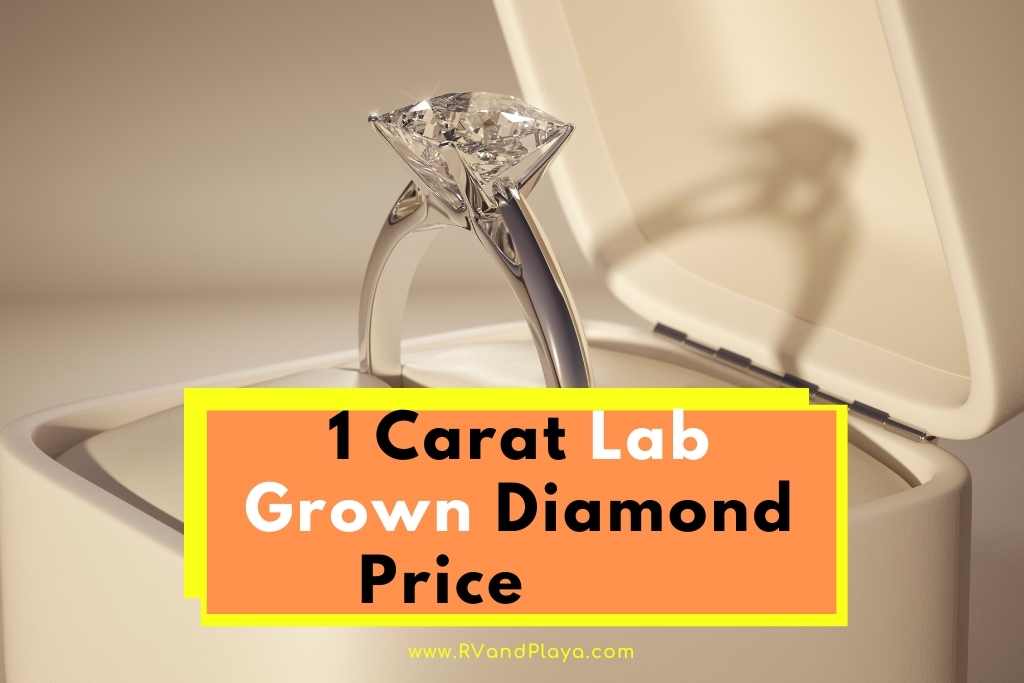Lindsey, do you know what 1 carat lab grown diamond price is? This is one of the questions our readers ask a lot. Well, we´ve got you covered.
When you’re shopping for diamonds, you’ve probably noticed the alternative option on the market that has completely changed things in the industry.
Lab-grown diamonds are everywhere these days, but are they a better option for most people? How much do they actually cost?
Per carat, a lab diamond is typically worth between $1,000 and $3,000, compared to the $3,000 – $8,000 that mined diamonds usually go for.
Read on ahead to discover everything you could possibly want to know about the price and quality of the lab diamonds on the shelves today.
Table of Contents
What Actually Are Lab-Grown Diamonds?
The first thing that everyone wants to know about lab-created diamonds is: Are they real? What exactly are they?
These diamonds are virtually identical in every meaningful way to diamonds mined from within the earth, the key difference is simply their origin. They are the same fundamental material and formed in much the same way too. Their structure and crystal characteristics are just like those of earth diamonds.
In fact, even a professional would find it almost impossible to tell the difference between a diamond that was formed in a lab and one that was created by nature.
In terms of their physical, optical, and thermal properties they are true and genuine diamonds, which is what makes their appearance in the industry such a game-changer.
Read also >> 2.5 Carat Lab Grown Diamond Price (Current Price)
Read also >> 5 Carat Lab Grown Diamond Price (Current Price + Buying Guide)
1-Carat Lab Grown Diamond Price
Now that we know exactly what lab-grown diamonds are, the qualities that they can have, and how they compare to the real thing – we can look at just how much you might expect to pay for one.
The table below shows the average price range that you will generally pay for diamonds of various sizes, but that cost does vary greatly depending on their individual characteristics.
| Size | Lab-Grown Diamonds Average Price | Natural Diamonds Average Price |
|---|---|---|
| 0.5 Carat | $500 – $700 | $800 – $1,300 |
| 1.0 Carat | $1,000 – $3,000 | $3,000 – $8,000 |
| 2.0 Carat | $5,000 – $10,000 | $12,000 – $20,000 |
| 3.0 Carat | $18,000 – $30,000 | $25,00 – $45,000 |
Are Lab-Grown Diamonds Cheaper Than Mined Diamonds?
One of the most significant differences between diamonds created in a laboratory and those that form naturally is the value that they hold.
The process of forming lab diamonds might be a complicated one, but it is far less expensive, more sustainable, and kinder to the environment than mining and drilling.
This means that the price of these incredible gemstones is significantly less, even when the quality is exactly the same.
In general, you can expect to pay 30-60% less for a lab-created diamond than you would for a mined stone with the exact same size and characteristics.
Lab-created diamonds will also have a much lower resale value. Although it is very difficult to determine the origin of any diamond independently, all diamonds need to display their origin when they are sold, and this information will be retained for the life of the stone.
You should always be clearly shown whether a diamond was mined or whether it was grown in a lab.
- Save an Average of $350* on Lab-Created Diamonds
- James Allen is the leader in online diamond sales
Is It Better To Choose Lab-Grown Diamonds?
When it comes to choosing between science and nature, there are a lot of different factors to consider.
If you want a diamond that looks and feels both beautiful and valuable but comes with a smaller price tag, then lab-grown is a great option to choose. These stones are completely genuine, and their appearance and characteristics will be graded in exactly the same way. The main difference is that they are a lot cheaper to purchase.
Additionally, lab-created diamonds have less of a negative impact on the planet and they are 100% free from the conflict and exploitation that has clouded the diamond mining industry for many years.
On the other hand, if the inherent value is what is most important to you then a mined diamond is probably the way to go.
These stones hold their higher value and will almost always sell for more than lab-grown alternatives that have the exact same features.
You will also find that most modern mined diamonds are entirely conflict-free and the rules and regulations for sustainable, fairly compensated mining have greatly improved over the years.
- Save an Average of $350* on Lab-Created Diamonds
- James Allen is the leader in online diamond sales
How Do You Know That A Diamond Is Lab Grown?
If lab diamonds are so similar to the real thing that even an expert cannot truly tell them apart, then how do you know the origins of the gemstones that you are looking to purchase?
Well, all of this information will be in the diamond grading document that your stone should come with.
Every valuable gemstone should be independently assessed by a third party and it should have some authorized documentation that describes its features and its origin.
When you look at your diamond grading document, it will either say that the diamond was naturally formed or lab-created. If it is a man-made diamond, then it should also tell you which method was used.
These grading documents are incredibly important to obtain and keep hold of for any gemstone that holds significant value.
How Are Lab-Grown Diamonds Graded?
The true value of any diamond will come down to its major features and characteristics. These are the other things that will be detailed within a grading document, besides origin.
Lab-grown diamonds and mined diamonds are assessed and graded by the major gemological institutes in exactly the same way that any other diamonds are.
The most significant characteristics that will be assessed are the “4 Cs”, which are Carat, Color, Cut, and Clarity.
- Carat: The carat of a diamond is a simple measurement of how much it weighs. One carat is equal to 0.2 grams.
- Color: The color of a diamond measures how much visible coloration can be seen in the stone. For colorless diamonds, this grade will be from a completely clear D to a slightly yellow Z. For fancy color diamonds, it will describe how vivid the color is.
- Cut: The cut of a diamond measures how well it has been shaped in terms of the facets that have been cut into it. A well-cut diamond appears brighter and will reflect more light.
- Clarity: The clarity of a diamond measures how many blemishes or inclusions are visible. These will typically be incredibly minor, so they are viewed under 10X magnification.
These reports are generated by a number of different laboratories around the world, but the most well-known and reputable are the Gemological Institute of America (GIA), the American Gem Society (AGS), and the International Gemological Institute (IGI).
How Are Diamonds Grown In A Lab?
The actual process of growing diamonds in a lab is a fascinating one, and there are a few different methods.
These methods are comparable to how diamonds form underground. Naturally, diamonds develop under very high temperatures and extreme pressures that compress carbon into a very dense and highly compact form. This form of carbon is the diamond crystal, and it is made up of a very specific geometric lattice of carbon molecules.
The two laboratory growth methods that are most commonly used are known as HPHT and CVD. Both methods start with a small amount of diamond known as a “diamond seed”
HPHT (High Pressure High Temperature)
- The diamond seed is held in a capsule with a starting material that is made up of carbon (usually graphite).
- The capsule is put in a press.
- The diamond seed and starting material are heated up to between 1,300ºC and 1,600ºC and pressed with up to 60,000atm of pressure.
- The carbon starting material with then dissolve and begin to form around the diamond seed.
- The diamond will then grow. This can take hours or it can take weeks, depending on how large it is going to become.
CVD (Chemical Vapor Deposition)
- A chamber is filled with a carbon-rich mixture of gasses.
- A seed is put inside the chamber.
- This is then heated to between 800ºC and 900ºC.
- The energy causes the carbon to precipitate from the gasses and attach itself to the diamond seed.
- The diamond will then grow.
James Allen is the leader in online diamond sales. Their imaging technology is the same as inspecting a diamond with a jeweler's loupe. They have the largest exclusive loose diamond inventory online and fantastic prices.
They also have the nicest collection of lab created diamonds online. Save 10% off select lab grown diamonds and 25% off ring settings during limited time sale!
WHAT WE LOVE ABOUT THEM:
- No questions asked returns within 30 days of shipment. James Allen will send you a paid shipping label to return the ring.
- Lifetime Warranty
- Free International Shipping
- Free prong tightening, repolishing, rhodium plating and cleaning every 6 months
- Provide insurance appraisals
- One free resizing within 60 days of purchase
- Free ring inscriptions
- Best-in-class high quality imagery of all diamonds in stock
- 24/7 Customer Service
- Best-in-class packaging
Summary
So, what is the price of a 1-carat diamond that was grown in a lab? Although they are practically identical to mined diamonds in almost every single way, these alternatives are significantly cheaper to buy.
They tend to be between 30% and 60% less than mined alternatives and for a 1.0-carat stone, you would expect to pay $1,000 – $3,000.
Lab-created diamonds are an affordable, sustainable, and ethical alternative to regular diamonds, but they do hold less value over time – which is an important factor to consider when you are shopping around.
References
https://www.gemsociety.org/article/lab-grown-diamond-pricing/
Recent Posts
5 Carat Lab Grown Diamond Price (Current Price + Buying Guide)
In the world of diamond shopping, there are a few guidelines it's good to know. Such as higher carat equals higher price, but lab produced diamonds are usually less expensive than naturally mined...
Shopping for diamonds is a tricky business and trying to find something of significant size can become almost impossibly expensive. If you want to find some more affordable options, then you will...


